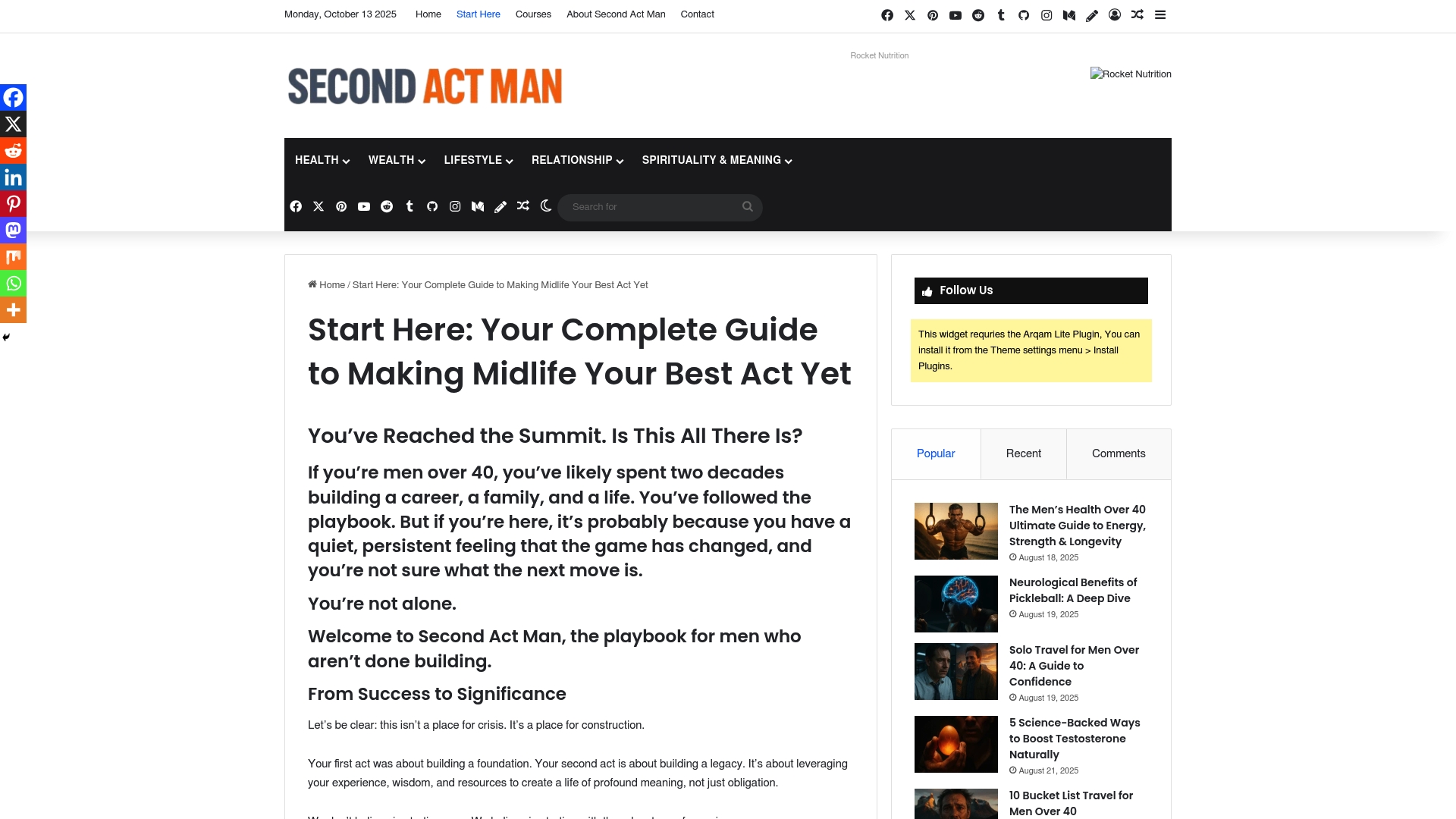Why Upskilling Matters After 40: Complete Guide

Did you know that 70% of professionals consider upskilling crucial after turning 40? This stage of life often brings both career uncertainty and untapped possibilities. As job markets evolve, many men find themselves craving greater relevance, flexibility, and satisfaction in their work. Discover how targeted learning defies outdated myths, strengthens professional confidence, and transforms experience into your most valuable asset—even amid rapid change.
Table of Contents
- Defining Upskilling After 40 And Common Myths
- Motivations For Midlife Upskilling And Change
- Key Benefits: Career, Confidence, And Purpose
- Popular Upskilling Paths For Men Over 40
- Risks Of Stagnation And Missed Opportunities
- Proven Strategies For Successful Upskilling
Key Takeaways
| Point | Details |
|---|---|
| Embrace Lifelong Learning | Upskilling after 40 is crucial for career resilience and adaptability in a changing job market. Continuous learning enhances professional value and opens new career pathways. |
| Overcome Myths About Age and Learning | Age should not be seen as a barrier to skill acquisition; neuroplasticity supports lifelong learning potential. Intentional development is accessible regardless of age. |
| Focus on Strategic Skill Acquisition | Identify skill gaps specific to your industry and aim for high-demand, transferable skills to stay relevant in the workforce. Tailor your learning methods to fit your lifestyle. |
| Recognize Motivations and Benefits | Motivations for midlife upskilling include job security, personal growth, and enhanced confidence. The results can lead to increased earning potential and deeper job satisfaction. |
Defining Upskilling After 40 And Common Myths
Upskilling isn’t just corporate jargon—it’s your strategic lifeline for career resilience after 40. According to research from the OECD, adults are increasingly challenged to retrain and explore alternative career paths in a rapidly transforming work environment. Think of upskilling as your personal career update: systematically acquiring new skills that enhance your professional value and adaptability.
Common myths about learning in midlife can hold you back. Many men incorrectly believe that their capacity to learn diminishes after 40. False. The Deliberate Man: A Guide to Intentional Living emphasizes that intentional skill development is a mindset, not an age-restricted activity. Neuroplasticity proves our brains remain capable of significant learning throughout our lifetime, debunking the outdated notion that you can’t teach an old dog new tricks.
Effective upskilling after 40 involves strategic, targeted learning. This means:
- Identifying skill gaps in your current industry
- Selecting learning methods that fit your lifestyle
- Focusing on transferable, high-demand skills
- Embracing technology and digital literacy
Research indicates that increasing adult learning participation is crucial for adapting to evolving labor market demands. Your age is an asset, not a limitation—bringing decades of experience that can be powerfully augmented by new technical and soft skills.

Motivations For Midlife Upskilling And Change
Job security sits at the heart of midlife upskilling motivation. According to a recent survey, 70% of professionals recognize upskilling as critical for maintaining their professional relevance. This statistic isn’t just a number—it’s a wake-up call for men navigating career transitions after 40. The Midlife Career Reinvention: Design Your Next Chapter underscores how strategic skill development can transform career uncertainty into opportunity.
Motivation for learning in midlife goes beyond mere job preservation. Research demonstrates that middle-aged men are driven by deeper psychological factors: a desire for personal growth, intellectual challenge, and maintaining professional competitiveness. These intrinsic motivations often supersede external pressures, making skill acquisition a deeply personal journey of self-improvement and empowerment.
Key motivational drivers for midlife upskilling include:
- Staying relevant in a technology-driven job market
- Increasing earning potential
- Creating career flexibility
- Boosting personal confidence and professional satisfaction
- Preparing for potential career pivots
As research indicates, motivation is the fundamental catalyst for adult education. Your willingness to learn, adapt, and grow becomes the most powerful tool in reshaping your professional narrative. This isn’t about competing with younger workers—it’s about leveraging your accumulated wisdom while strategically expanding your skill set.
Key Benefits: Career, Confidence, And Purpose
Upskilling after 40 is a strategic pathway to career resilience in an increasingly dynamic job market. According to OECD research, traditional career trajectories are rapidly evolving, driven by technological advancements and economic shifts. The Midlife Reboot: A Man’s Guide to Mastering the Second Act illuminates how proactive skill development can transform career uncertainty into opportunity.
The benefits extend far beyond professional survival. Continuous learning triggers a powerful psychological transformation, rebuilding confidence that might have eroded during career plateaus. By acquiring new skills, you’re not just updating your resume—you’re rewiring your self-perception, proving to yourself that potential has no expiration date.
Key benefits of midlife upskilling include:
- Expanded career opportunities
- Enhanced market adaptability
- Increased earning potential
- Deeper professional satisfaction
- Renewed sense of personal purpose
Research highlights a critical insight: career guidance is a fundamental lever for navigating an evolving labor market. Your commitment to learning becomes a compass, helping you chart meaningful professional trajectories in an era of unprecedented workplace transformation. This isn’t about keeping up—it’s about stepping forward with intention, expertise, and renewed confidence.
Here’s a summary comparing key benefits and risks of upskilling after 40:
| Aspect | Upskilling After 40 | Professional Stagnation |
|---|---|---|
| Career Opportunities | Expanded Flexible options | Limited Narrow choices |
| Market Adaptability | High Technologically current | Low Vulnerable to change |
| Earning Potential | Increased | Decreased |
| Professional Confidence | Boosted Renewed sense | Reduced Plateau effect |
| Sense of Purpose | Strong Growth-focused | Weak Stagnant feeling |
Popular Upskilling Paths For Men Over 40
The landscape of professional development has dramatically transformed, offering multiple learning pathways tailored for men seeking meaningful career growth. Online learning platforms, professional certifications, and targeted training programs have become accessible alternatives to traditional educational routes. Choosing the Right Multivitamin for Men Over 40 demonstrates how strategic self-improvement extends beyond professional skills into holistic personal development.
Technology and digital skills represent the most dynamic upskilling opportunities. Emerging fields like data analytics, cybersecurity, digital marketing, and artificial intelligence offer robust career reinvention pathways. These domains welcome experienced professionals who can blend technological expertise with their existing industry knowledge—creating a powerful competitive advantage.
Popular upskilling paths include:
- Online certificate programs from accredited universities
- Professional skill bootcamps
- Industry-specific digital credentials
- Self-paced learning platforms like Coursera and edX
- Micro-credential programs focusing on emerging technologies
Research highlights the importance of structured career conversations and continuous learning. Your upskilling journey isn’t just about acquiring new skills—it’s about strategically positioning yourself in an evolving professional landscape, transforming career challenges into opportunities for meaningful growth and personal reinvention.
Risks Of Stagnation And Missed Opportunities
Skill stagnation is more than a professional inconvenience—it’s a potential career death sentence for men over 40. Professional inertia can rapidly erode your market value, pushing you towards irrelevance in an increasingly dynamic job landscape. The Midlife Reboot: A Man’s Guide to Mastering the Second Act powerfully illustrates how quickly technological shifts can render existing skill sets obsolete.
According to OECD research, many adults face significant barriers to learning, often rooted in psychological obstacles like believing they’re too old to acquire new skills. These attitudinal barriers create a self-fulfilling prophecy: by assuming learning is impossible, professionals limit their own potential, creating precisely the skills gap they fear.
Risks of professional stagnation include:
- Decreased earning potential
- Higher vulnerability to technological disruption
- Reduced job market competitiveness
- Limited career advancement opportunities
- Increased likelihood of involuntary career transitions
Research suggests that increasing motivation through targeted learning incentives can help overcome these barriers. Your career isn’t a fixed trajectory—it’s a dynamic journey requiring continuous adaptation. Stagnation isn’t an inevitability; it’s a choice. By recognizing and confronting these risks, you transform potential limitations into opportunities for remarkable professional reinvention.
Proven Strategies For Successful Upskilling
Strategic learning requires more than good intentions—it demands a structured, intentional approach. The Midlife Reboot: A Man’s Guide to Mastering the Second Act emphasizes that successful upskilling is a deliberate process of identifying, targeting, and systematically acquiring relevant skills that align with your career objectives.
According to OECD research, an integrated approach to career development is crucial. This means creating a comprehensive strategy that combines personal motivation, targeted skill acquisition, and ongoing professional guidance. The most successful upskilling journeys are those where individuals view learning as a continuous, adaptive process rather than a one-time event.
Proven strategies for effective upskilling include:
- Conducting a comprehensive skills gap analysis
- Setting clear, measurable learning objectives
- Developing a personalized learning roadmap
- Leveraging both online and in-person learning resources
- Seeking mentorship and professional networking opportunities
- Implementing a consistent, disciplined learning schedule
- Applying new skills immediately in practical scenarios
The theory of Motivating Change suggests that creating the right psychosocial-structural conditions is essential for sustained personal transformation. Your upskilling journey is not just about acquiring technical skills—it’s about reshaping your professional identity, building confidence, and positioning yourself as a dynamic, adaptable professional who thrives in an ever-changing marketplace.
Take Charge of Your Next Chapter with Upskilling After 40
Feeling stuck or uncertain about your career path after 40 is common but it does not have to define your future. This article highlights the real challenges of skill stagnation and the powerful benefits of targeted upskilling like regaining confidence and expanding career options. If you relate to the need for meaningful change through learning new skills and want practical support on this journey, SecondActMan is here to empower you.

Explore our Men’s Health Over 40: A Practical Guide to Fitness, Hormones & Vitality to fuel your physical and mental stamina alongside career growth. Dive into proven strategies for reinvention and purposeful living by visiting Second Act Man Start Here today. Your second act starts now with the resources and guidance designed specifically for men navigating life and career transitions after 40.
Frequently Asked Questions
What is upskilling, and why is it important after 40?
Upskilling refers to the process of acquiring new skills to enhance professional value and adaptability. After 40, it becomes crucial for maintaining job relevance and navigating career transitions in a rapidly changing work environment.
How can I identify the skills I need to upskill?
Conducting a skills gap analysis in your current industry can help you identify which skills are lacking or high in demand. Focus on transferable skills that align with your career goals.
What are some effective methods for upskilling?
Effective upskilling methods include online certification programs, professional bootcamps, self-paced learning platforms, and industry-specific training. Choose the method that best fits your lifestyle and learning style.
What are the risks of not upskilling after 40?
Not upskilling can lead to decreased earning potential, limited job market competitiveness, and vulnerability to technological disruptions, which can jeopardize career advancement and job security.
Recommended
- 12 Testosterone Boosting Foods for Men: A Guide for Midlife Vitality
- The Midlife Career Reinvention: Design Your Next Chapter
- The Midlife Reboot: A Man’s Guide to Mastering the Second Act
- Best ED Treatments (2025): Top 4 Online Options Reviewed
- 7 Actionable Steps to Define and Achieve Personal Career Goals – Tariq Juneja
- Understanding The Importance Of Digital Literacy Today







